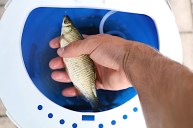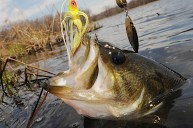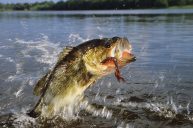Learn the Ned rig, because this finesse technique catches a lot of fish!
In bass fishing, sometimes we over-think things. Bass anglers are always looking for the next big technique or the next hot lure.
But sometimes, the most effective fishing techniques are done with some of the simplest components in your tackle box.
Enter the Ned rig. It's an unbelievably simple fishing method that consistently catches big fish, and if you aren't using it, you should seriously consider changing that.
What is a Ned rig?
We did some diving into the history of this finesse presentation. It seems many anglers are confused about just how and where it originated. It just sort of appeared out of seemingly nowhere a few years ago and took the bass angling world by storm.
The Ned rig is sometimes referred to as the "Midwest finesse" rig because it has its origins there. It seems fishing writer Ned Kehde largely came up with the idea fishing waters around Kansas City. Another writer, Steve Quinn, was the one who came up with the now the iconic name.
From what we understand, the whole concept of the Ned rig was simply a variation on using another iconic lure, the Beetle Spin, but without the spinner arm component. From there, it morphed to using small plastic worms similar to Senkos.
The Ned rig is as simplistic as it gets. It hinges a mushroom head jighead, anywhere from 1/15 to 1/8 ounces at the most. On the jighead, a small piece of plastic bait, usually between 2 ¾ ad 3 inches, is threaded. That's it. That's the whole Ned rig, we're not kidding! Some anglers like to use a fluorocarbon leader, but that is up to each angler's preferences.
This allows the tail end of the bait a lot of freedom of movement and excellent action.
You might be thinking this setup is too silly and simple to work. I admit, I thought the same the first time I heard about it. You might also be thinking those jigheads are too light for bass. We don't blame you, a lot of anglers think the same when they first hear about it. Since then, there have been a bevy of new Ned rig products introduced specifically for this style of fishing. Ned heads, shaky heads, Z-man Finesse TRDs, and Finesse Shroomz jigheads to name a few.
In fact, some of the jigs are small enough to use on crappie or panfish. To us, these baits aren't much to look at. But if you don't think it will catch bass, you're wrong.
This style of fishing may seem strange to some, but it is highly effective on both largemouths and smallmouths.
How to tie a Ned rig
Setting up a Ned rig is as simple as the lure and hook. All you do is tie on a mushroom head jig, thread the tail of your preferred soft plastic stickbait over the shank of the hook and you're good to go.
Because the lure is so light, you do have to use extremely light fishing gear. We're talking four to six-pound test line at the most on a spinning rod with fluorocarbon or monofilament line. Most of the pros are using light to medium-light action rods for this technique these days. Any heavier than that are you start to lose some feel for working the lure.
Now, you could simply trim Senkos or other soft plastics to use for this fishing technique, but tackle companies have taken notice of the Ned rig. In fact, several are offering lures and jigheads specifically made for this technique.
The most popular ones right now are probably Z-Man's "Finesse Shroomz" jigheads paired up with "Finesse TRD" stickbaits. The company advertises these baits as having "Elaztech plastics" technology, which is supposed to make them more durable without sacrificing action.
Plenty of major tackle companies are now offering ned rig jig heads and ned rig baits. Surprisingly, these finesse baits are incredibly affordable at just $3.99 a bag. We like colors like green pumpkin or craw for a combo that helps match the hatch on crawfish perfectly. Ned worms are cheap, durable and it catches loads of fish? What's not to like about that?
Z-man isn't the only company jumping on Ned rig bandwagon. Roboworm, Strike King, Yamamoto, Matzuo, Berkley, and more have begun making specialty worms made just for Ned rigs. Some variations on the jigheads have started popping up too. Now companies are starting to make mushroom heads with weedguards, although it's worth noting the original rig is pretty weedless on its own.
How to fish a Ned rig
As if the rest of this finesse fishing setup wasn't simple enough, fishing this rig is as easy as it gets. Let the bait fall to the bottom and simply retrieve or bump it along the floor. And catch fish. That's it.
The worms being used for Ned rigs now are being built to float. This means the tail end of the bait is going to point up as you work it along the bottom. When used right, the bait closely resembles small minnows, gobies and other bottom-feeding baitfish that bass like to prey upon.
Some worms come with a small set of legs or claws that help the bait resemble crayfish scurrying across the bottom. It's like ringing the dinner bell for a smallmouth or largemouth bass! The technique is used mostly waters with rocky bottoms, but these rigs work just about anywhere. By using lighter colors you can get action that makes the bait resemble a shad on the bottom.
Don't be afraid to experiment with retrieves. It seems just about any will work with this finesse rig in both deep and shallow water.
The simplicity of the lure means it can make for a great introduction to artificial lures for children because it the retrieve doesn't need to be as complicated as a Texas rig, topwater or swimbait.
Ned rig fishing has quickly gained a reputation as being a technique that seems to work when all others fail. We're now starting to see professional tournament anglers going to Ned rigs when they need to get fish in the boat in a hurry. Some anglers swear by the Ned rig for tough conditions, like cold water in the winter when bass are less active.
One thing that bears mentioning is to be careful on your hooksets. These are small lures and small hooks. You simply can't set the hook like normal. Either start reeling in the spinning reel and let the fish hook itself, or use a sideways sweeping motion for your hookset, like what you'd do with a circle hook on a catfish or walleye.
Remember to be alert as you're letting the lure fall after the cast. Many strikes come on the fall.
Also, make sure you don't force the fish in too hard with the fight. You have to play the fish carefully to avoid popping the hook loose.
What makes the big difference is the durable nature of these baits, especially the Elaztech baits we mentioned earlier. Many anglers believe the worms used for Ned rigs get better with age and abuse.
The more torn up these deadstick baits get, the better the action. Who would have thought? It's a refreshing change of pace from expensive soft plastics that only last a fish or two at the most.
There is a lot to love about Ned rigs. It's a simple, cheap and highly effective way to fish that works when all other techniques fail. No matter where you live, it's worth at least trying it once. You never know, you may have just found a new favorite fishing technique!
For more outdoor content from Travis Smola, be sure to follow him on Twitter and check out his Geocaching and Outdoors with Travis YouTube channels.
NEXT: WATCH THE EASIEST WAY TO REMOVE A FISH HOOK
WATCH




